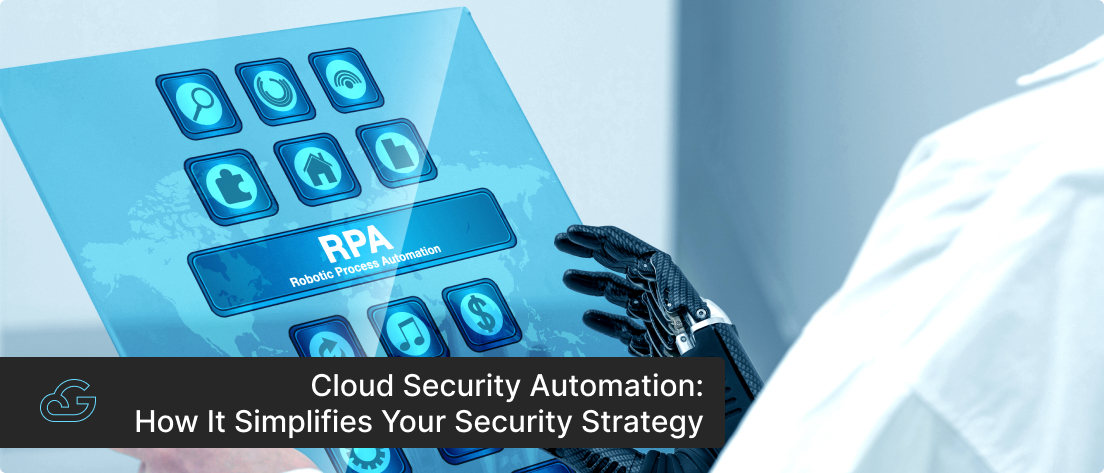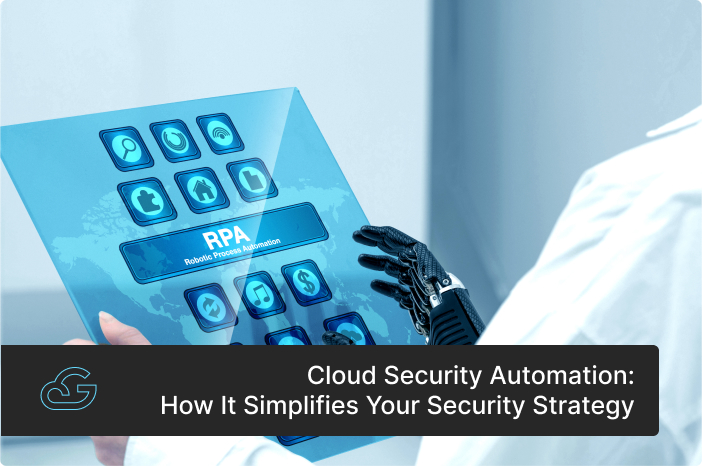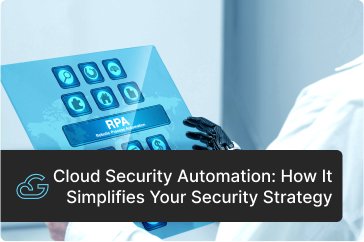Blogs / Cloud Security
Cloud Security Automation: How It Simplifies Your Security Strategy
By
Sibin Vincent
Posted: November 28, 2024
• 8 Minutes
The cloud is inherently scalable. You can dynamically assign cloud resources (computing power, storage, etc.) as per your demand. While this high level of flexibility can help optimize your operations, securing your cloud estate manually is a monumental challenge.
Just think about it. In a highly complex cloud architecture, thousands of resources are being rapidly spun up and down. This results in the creation of numerous access points such as APIs, user interfaces, network endpoints, databases, and service connections through which data is flowing constantly. Now imagine manually implementing security measures for each of these elements. Obviously, you are going to be overwhelmed, invariably leaving security gaps and creating vulnerabilities for threat actors to exploit.
Cloud security automation is the solution to overcoming this security challenge. You can tap into the vast possibilities of cloud technology without having to worry about the safety of your cloud applications, data, and infrastructure by automating the important elements of your cloud security. But how does it work? How can you implement cloud security automation strategically? What are some of the best practices around cloud security automation? Let’s delve into these details.
What is Cloud Security Automation?
Cloud security automation is all about automatically applying the optimal security settings to your dynamic cloud environments. This automation process relies on various tools (Terraform, Ansible, Puppet, Amazon CloudWatch, etc.) to monitor and manage your cloud environments, detect vulnerabilities at speed and scale, respond to security incidents in real-time, etc. With cloud security automation, you can eliminate time-consuming security tasks, such as manual configuration, patching, monitoring, and compliance checks, and minimize human intervention. This will help you achieve operational efficiency and enhance your security posture.
Understand the Difference Between Cloud Security Automation and Orchestration
Cloud Security Automation: Involves automating specific, individual security tasks like ‘vulnerability scanning’ or ‘drift management’ to execute them automatically without human intervention.
Cloud Security Orchestration: Coordinates and manages multiple security processes, tools, and responses to work together seamlessly across your cloud environment, ensuring a unified security approach.
Is Cloud Security Automation Important?
According to the latest market insights, around 44% of companies using cloud technology have experienced a data breach incident. As the influence of cloud technology grows, you must understand that the chances of it being targeted by cyber adversaries also increase. On top of that, modern-day organizations are moving to multi-cloud architectures and focusing on building cloud-native applications by relying on containerization technology and IaC (Infrastructure as Code).
Multi-cloud architecture involves managing resources across multiple providers, each with its own security protocols, making consistent policy enforcement difficult. Containerization creates rapid, short-lived instances that are hard to track and secure with traditional, static security methods. Infrastructure as Code (IaC) continuously provisions and modifies resources, which requires automated security to ensure policies are applied consistently, and errors are avoided in a constantly changing environment.
Traditional security mechanisms that primarily focus on manual techniques and processes simply can’t handle such dynamic and complex cloud environments. For instance, take a look at this IaC snippet below:
Server:
type: “medium”
location: “us-east”
firewall:
- allow_port: “all”
- allow_source: “0.0.0.0/0”
There are two major misconfigurations in this code:
- allow-port: “all”. Instead of opening specific ports (like 443 for HTTPS), this command keeps all the ports open. This exposes every possible entry point to your server.
- allow_source: “0.0.0.0/0”. This command removes all IP restrictions (specific IP addresses, office IP addresses, etc.), allowing anyone from anywhere to access the server.
These commands might not be a serious problem during the testing phase. However, imagine if this misconfigured code was used in the deployment phase to allocate 100 servers. You would have 100 servers that are completely vulnerable to attacks.
These are some of the reasons that make cloud security automation an absolute necessity. While the cloud offers extensive benefits, it is easy to get stranded in its complex terrain and lose focus of security. With threat actors circling around to take advantage of any oversights from your side, you need a technology that can adapt to the dynamic and scalable nature of the cloud, and that is exactly what cloud security automation is.
Now, let’s look at the technical side of cloud security automation. We will begin by identifying the elements of cloud security that can be automated.
Which Elements of Cloud Security Can Be Automated?
-
Security Configuration & Drift Management:
Configuring your security protocols and ensuring that these configurations
are being followed without deviations are important elements of cloud security.
However, these tasks can become tedious and error-prone as your cloud estate
grows.
Instead, you can automate them using scripts that feature predefined security configurations (for example, setting up a new firewall, encryption, and access controls whenever a new server is allocated). This way, you can ensure that security configurations are applied consistently while automatically detecting and preventing any unauthorized deviations from your security baseline.
-
IaC:
Practices such as IaC are important for your CI/CD pipelines as they help
in the rapid provisioning and effective management of resources in cloud
environments. But what if there is an error or oversight in your IaC template?
As highlighted in the earlier section (the 100 exposed server example), the
consequences can be dire.
You can avoid this scenario by automating security controls within your IaC process. By doing this, you can facilitate automatic scanning for misconfigurations in infrastructure, enforce security best practices, and remove potential vulnerabilities in resources before deployment.
-
Container Deployments:
Container deployments can become security vulnerabilities if strict security
controls aren’t instilled during the build phase, registry push, and final
deployment. But doing this manually is impractical as there are multiple
security checks required at each stage. For instance, in the build phase
alone, you must look for vulnerable software components, outdated libraries,
malicious codes, etc.
You can automate all the necessary checks across the entire container lifecycle—from scanning images during creation to validating security when storing them in registries and finally ensuring secure deployment to staging and production environments. To do so, you can use container orchestration tools like Kubernetes, which can build security directly into container images while enforcing strict security standards.
-
Vulnerability Scanning:
Automating vulnerability scanning is extremely beneficial for your cloud
environment. Unlike traditional scanning, which is often scheduled periodically,
automated vulnerability scanning ensures that you are able to continuously
scour your cloud estate looking for any sort of vulnerabilities.
This scanning covers multiple layers of your cloud infrastructure, from applications running in production to new deployments, IaC templates, cloud instances, APIs, networks, storage buckets, and much more.
-
Compliance Monitoring:
If you are operating in the cloud, adhering to regulatory mandates is extremely
important. But, manual compliance monitoring across a vast cloud environment
can be overwhelming as different regulations (HIPAA, SOC2, etc.) have specific
requirements that need to be followed.
This process can be streamlined with automation. You can set up compliance policies that are automatically enforced across your cloud environment. With this, when a non-compliance instance occurs, it gets immediately flagged, and you can take the necessary measures to rectify it.
Additionally, to stay compliant, you must also maintain in-depth documentation and be prepared for audits. By integrating your automated compliance monitoring process with tools like Azure Log Analytics, AWS CloudTrail, or Google Cloud’s operations suite, you can automatically generate compliance reports and maintain audit trails, enabling real-time visibility into your compliance status.
-
Incident Response & Remediation:
The speed and effectiveness of your response and remediation actions can
make a crucial difference when security incidents occur in your cloud environment.
Manually investigating thousands of cloud resources and implementing solutions
are both resource-intensive and time-consuming. This manual process can lead
to an increased dwell time, which in turn amplifies the impact of an incident.
Automating incident response and remediation ensures that the dwell time is drastically reduced, and immediate actions are executed when security issues are detected. For example, imagine that one of your SaaS applications is experiencing a surge in network traffic from suspicious IP addresses. With automated incident response, the system can immediately detect this anomaly, block suspicious IP addresses, and isolate the affected application components while alerting your security team.
Implementing Cloud Security Automation: A Strategic Approach
Designing a comprehensive cloud security automation plan and executing it is not easy. You need to strategically evaluate various elements of your cloud ecosystem, define security policies elaborately, interconnect various tools and functions with each other.
That pretty much sums up the technical side of cloud security automation. By now, you would have understood how you can strategically implement it. But that’s not enough. To leverage cloud security automation to the fullest, you must follow certain best practices that ensure your automation is effective, reliable, and sustainable. Let’s look at these key practices in the next section.
Best Practices for Cloud Security Automation
- Establish Clear Automation Triggers: Accuracy and timeliness are extremely vital when it comes to cloud security automation. And to achieve both, you must clearly define what triggers your automated responses. Whether it’s specific security events, configuration changes, unauthorized access, or policy and compliance violations, having well-defined triggers ensures your automation responds appropriately and at the right time. This prevents both delayed responses and unnecessary automated actions.
- Take a Phased Approach: When it comes to cloud security automation, always remember to take it slow, especially if you were relying on manual security processes in the past. Start by automating simple security tasks and then gradually move to more complicated processes. This enables you to clearly understand how automation is impacting your security posture and allows your team to adjust and adapt to automated workflows. For instance, begin with basic tasks like automated security scans and then progress to sophisticated automation actions like remediation, which involves numerous integrations and workflows.
- Include Rollback Mechanisms: When it comes to cloud security automation, there are numerous variables, and anything can go wrong. Therefore, you must ensure that your automated security processes include rollback mechanisms. That is, if automating any of your cloud security elements causes an issue, the system should automatically revert to the last known secure state immediately. This way, you can prevent automation errors from manifesting into new security vulnerabilities.
- Create Feedback Loops: Feedback loops are critical for fine-tuning your cloud security automation plan. You must set up feedback loops in a way that they can collect, integrate, and analyze data on false positives, missed threats, automation failures, and much more. This way, your cloud security plan can continuously learn and adapt, ultimately achieving optimal results.
- Maintain Flexibility: You must always remember that both your cloud environment and your organization’s security requirements can change frequently. Therefore, it is absolutely essential that your cloud security plan is built in a flexible manner without requiring a complete rebuild. Use modular approaches that allow you to update specific components without disrupting the entire automation chain.
- Incorporate Continuous Testing: Testing your automation workflows in a staged environment is crucial. It will prevent automation from accidentally introducing new vulnerabilities. For instance, before applying automated security patches or configuration changes, run automated tests to verify they won't disrupt existing security controls or create conflicts. Also, implement automated validation checks that can verify if security automation is functioning as intended.
Automate Your Cloud Security with Gsoft
As a managed cloud and cybersecurity service provider, Gsoft is uniquely positioned at the intersection of cloud computing and cybersecurity. Our expertise and experience span both these streams, giving us the leverage to deliver best-in-class services to our clients. With organizations rapidly adopting cloud technologies for digital transformation, the attack surface has expanded significantly, creating new security challenges that traditional approaches cannot address. This is why we have developed a comprehensive cloud security automation framework that helps organizations strengthen their security posture while maintaining operational efficiency.
Our process entails:
- Initial assessment
- Thorough evaluation of current cloud environment
- Identification of security gaps and automation opportunities
- Analysis of existing security tools and processes
- Creating customized automation roadmap
- Strategic implementation
- Deploying automation solutions based on priorities
- Setting up automated security controls and monitoring
- Enabling automated incident response
- Establishing security baselines
Conclusion
Cloud security automation can bring incredible value to your organization. But you must also remember that it is an evolving practice. With technological advancements like Generative AI and deep learning making huge leaps in different domains, you can be certain that cloud security automation will continue to improve and become more sophisticated. To stay ahead and maximize its benefits:
- Explore advanced automation capabilities like AI-powered tools and intelligent workflows
- Build flexible and scalable automation frameworks that can adapt to future needs
- Regularly evaluate and optimize your automation processes
Want to know more about cloud security automation and how it protects your cloud estate from growing cyber threats? Contact us.


Get Know More About Our Services and Products
Reach to us if you have any queries on any of our products or Services.











